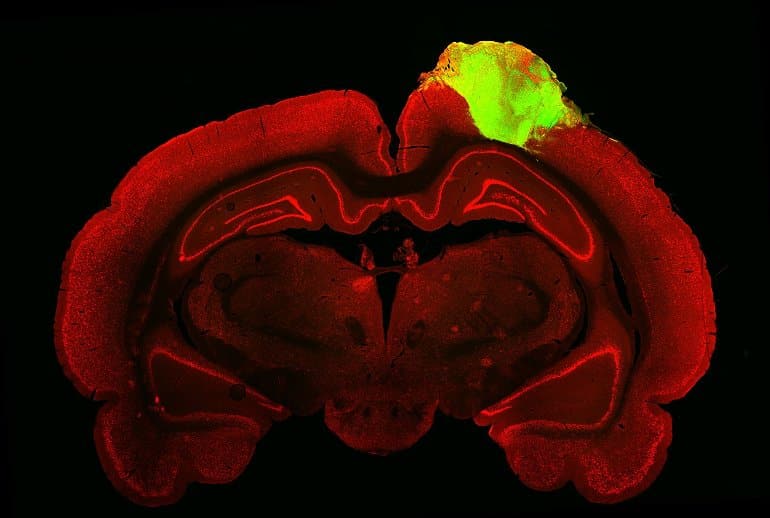Summary: Brain organoids created from human stem cells that were transplanted into the brains of rats responded to visual stimuli.
Source: Cell Press
In a study published in the journal Cell Stem Cell on February 2, researchers show that brain organoids—clumps of lab-grown neurons—can integrate with rat brains and respond to visual stimulation like flashing lights.
Decades of research has shown that we can transplant individual human and rodent neurons into rodent brains, and, more recently, it has been demonstrated that human brain organoids can integrate with developing rodent brains.
However, whether these organoid grafts can functionally integrate with the visual system of injured adult brains has yet to be explored.
“We focused on not just transplanting individual cells, but actually transplanting tissue,” says senior author H. Isaac Chen, a physician and Assistant Professor of Neurosurgery at the University of Pennsylvania.
“Brain organoids have architecture; they have structure that resembles the brain. We were able to look at individual neurons within this structure to gain a deeper understanding of the integration of transplanted organoids.”
The researchers cultivated human stem cell-derived neurons in the lab for around 80 days before grafting them into the brains of adult rats that had sustained injuries to their visual cortex.
Within three months, the grafted organoids had integrated with their host’s brain: becoming vascularized, growing in size and number, sending out neuronal projections, and forming synapses with the host’s neurons.
The team made use of fluorescent-tagged viruses that hop along synapses, from neuron to neuron, to detect and trace physical connections between the organoid and brain cells of the host rat.
“By injecting one of these viral tracers into the eye of the animal, we were able to trace the neuronal connections downstream from the retina,” says Chen. “The tracer got all the way to the organoid.”
Next, the researchers used electrode probes to measure the activity of individual neurons within the organoid when the animals were exposed to flashing lights and alternating white and black bars.
“We saw that a good number of neurons within the organoid responded to specific orientations of light, which gives us evidence that these organoid neurons were able to not just integrate with the visual system, but they were able to adopt very specific functions of the visual cortex.”

The team was surprised by the degree to which the organoids were able to integrate within only three months. “We were not expecting to see this degree of functional integration so early,” says Chen.
“There have been other studies looking at transplantation of individual cells that show that even nine or 10 months after you transplant human neurons into a rodent, they’re still not completely mature.”
“Neural tissues have the potential to rebuild areas of the injured brain,” says Chen. “We haven’t worked everything out, but this is a very solid first step.
“Now, we want to understand how organoids could be used in other areas of the cortex, not just the visual cortex, and we want to understand the rules that guide how organoid neurons integrate with the brain so that we can better control that process and make it happen faster.”
About this brain organoid research news
Author: Press Office
Source: Cell Press
Contact: Press Office – Cell Press
Image: The image is credited to Jgamadze et al
Original Research: Open access.
“Structural and functional integration of human forebrain organoids with the injured adult rat visual system” by Jgamadze et al. Cell Stem Cell
Abstract
Structural and functional integration of human forebrain organoids with the injured adult rat visual system
Highlights
- Human brain organoids integrate with the injured visual cortex of adult rats
- Organoid grafts are synaptically connected to the host retina and visual system
- Organoid neurons respond to host visual stimulation and adopt feature selectivity
Summary
Brain organoids created from human pluripotent stem cells represent a promising approach for brain repair. They acquire many structural features of the brain and raise the possibility of patient-matched repair. Whether these entities can integrate with host brain networks in the context of the injured adult mammalian brain is not well established.
Here, we provide structural and functional evidence that human brain organoids successfully integrate with the adult rat visual system after transplantation into large injury cavities in the visual cortex.
Virus-based trans-synaptic tracing reveals a polysynaptic pathway between organoid neurons and the host retina and reciprocal connectivity between the graft and other regions of the visual system.
Visual stimulation of host animals elicits responses in organoid neurons, including orientation selectivity.
These results demonstrate the ability of human brain organoids to adopt sophisticated function after insertion into large injury cavities, suggesting a translational strategy to restore function after cortical damage.






